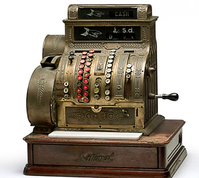








A cash register, also referred to as a till in the United Kingdom and other Commonwealth countries, is a mechanical or electronic device for registering and calculating transactions. It is usually attached to a drawer for storing cash and other valuables. The cash register is also usually attached to a printer, that can print out receipts for record keeping purposes.
In January 30, 1883, James Ritty and John Birch received a patent for inventing the cash register. James Ritty invented what was nicknamed the "Incorruptible Cashier" or the first working, mechanical cash register. His invention came with that familiar bell sound referred to in advertising as "The Bell Heard Round the World".
After reading a description of the cash register designed by James Ritty and sold by the National Manufacturing Company, John H. Patterson decided to buy both the company and the patent. He renamed the company the National Cash Register Company in 1884.
John Patterson improved the cash register by adding a paper roll to record sales transactions.
Charles F. Kettering designed a cash register with an electric motor in 1906, while working at the National Cash Register Company. He later worked at General Motors and invented an electric self-starter (ignition) for a Cadillac.